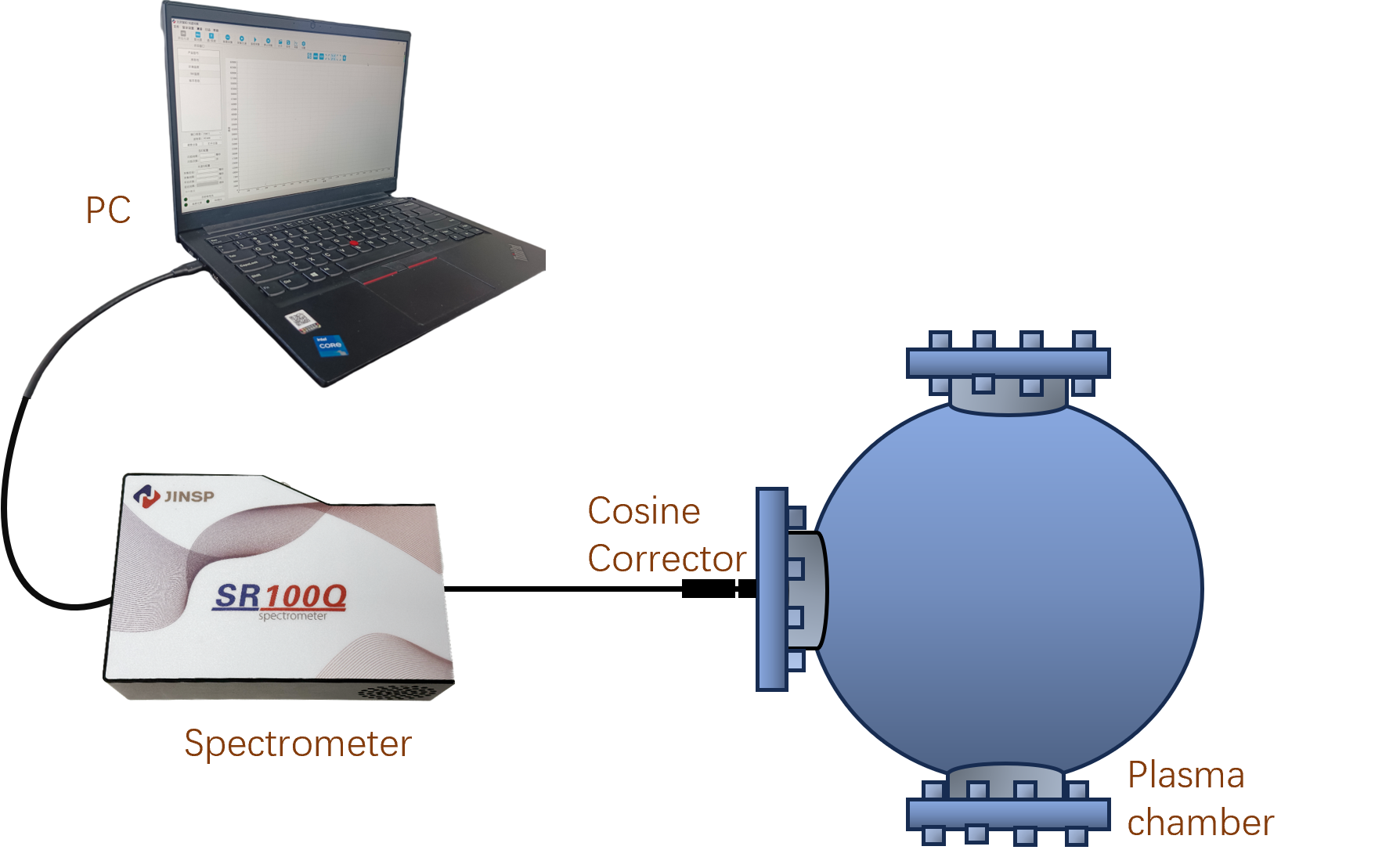1. Background
Plasma etching is a widely used dry etching technology in semiconductor manufacturing and other micro/nano processing fields. It utilizes high-energy ions and radicals in the plasma to physically bombard and chemically react with the material surface, achieving precise material etching. The plasma etching process involves complex physical and chemical interactions, including the interactions among charged particles and the rates and mechanisms of chemical reactions. These processes are difficult to fully simulate and analyze theoretically, requiring real-time monitoring and control through experimental methods.
2. Methods
There are various methods to monitor the etching process, such as mass spectrometry, Langmuir probes, impedance methods, optical reflectometry, and optical emission spectroscopy (OES). Among these, OES is a widely used mainstream endpoint detection technology. OES is a real-time, in-situ analysis technique that determines the composition and characteristics of substances by measuring the emitted spectra under specific conditions. It does not disturb the plasma etching process and can detect endpoint changes and parameter variations in the etching process.
3. Principle of OES Monitoring
In the plasma etching process, the elements detected by OES depend on the composition of the etched material and the possible reaction products and volatile groups formed during etching. OES determines the types and concentrations of elements by analyzing the spectra emitted from the plasma, thereby monitoring the etching process.
Specifically, OES can detect elements such as metal elements (e.g., aluminum, copper, iron), non-metal elements (e.g., silicon, oxygen, nitrogen), and volatile compounds that may form during the etching process. In semiconductor manufacturing, where plasma etching is often used for silicon-based materials, OES focuses on the spectral features of silicon. Additionally, if fluorine or chlorine-containing gases (e.g., SF6, Cl2) are used during etching, OES may also detect fluorine or chlorine spectral signals.
The elements and concentrations detected by OES are influenced by factors such as plasma excitation conditions, spectrometer resolution and sensitivity, and the sample's properties. Therefore, appropriate OES detection conditions and parameters need to be selected based on specific etching processes and materials.
As an advanced monitoring technique, OES plays a crucial role in semiconductor etching processes, particularly in endpoint detection. As the etching process progresses and the top film is gradually removed, revealing the underlying material, the gas environment within the plasma changes significantly. This change, due to the volatile etching byproducts released by the underlying material, directly affects the concentration of neutral substances in the plasma and their corresponding emission spectra intensity. By continuously monitoring the OES signal's temporal variations, the etching progress of the dielectric layer can be accurately tracked, effectively preventing over-etching.
OES can also detect impurity signals within the plasma. Under normal and abnormal operating conditions of the etching machine, the OES spectrum shows significant differences, providing a powerful tool for diagnosing potential system issues. For instance, comparing spectra can quickly identify if there is air leakage, improper adjustment of mass flow controllers (MFC) causing auxiliary gas flow anomalies, or contamination by impurity gases.
OES can assess plasma and etching uniformity, crucial for achieving high-quality etching by ensuring uniform distribution of plasma and chemical etchants over the wafer. Using multi-optical path measurement methods, OES can map the radial etching uniformity distribution, providing valuable data for process optimization. Experiments have shown a close relationship between OES signal intensity at different wafer locations and etching uniformity. Adjusting plasma parameters dynamically can effectively control and reduce radial etching non-uniformity.
OES can quantitatively measure concentrations of neutral particles, ions, and radicals within the plasma through linear emission spectra. Using inert gases with known concentrations (e.g., low concentration Ar) as exposure gases, whose characteristic emission lines resemble those of the active chemical ions being measured, allows indirect calculation of relative concentrations of plasma particles.
In Cl2 and Ar mixed gas etching environments, the relationship between Cl2 concentration and RF power is complex. Experimental data show that in bright field mode, spectrum intensity decreases with increasing RF power, highlighting OES's sensitivity and application value in complex plasma environments.
OES, with its convenience in component identification, high integration with etching equipment, and robust support for new process development and analysis, is a preferred tool in endpoint detection. However, the complexity of data interpretation and the large volume of raw data pose challenges in practical applications.
4. System Components
An OES detection system can use instruments like the Jinsp SR100Q spectrometer, which offers broad wavelength range coverage (UV-visible-near IR), high resolution, low stray light, high sensitivity, low noise, high signal-to-noise ratio, and easy software integration for high-speed testing. It can be customized with anti-aging fibers and cosine correctors to set up a monitoring system. The cosine corrector collects plasma spectra from the reaction chamber through the window, transmitting signals via optical fiber to the spectrometer for processing, outputting monitoring spectra for analysis.

5. Application Examples and Advantages
Application examples of fiber spectrometers in plasma etching include but are not limited to:
● Real-time monitoring of changes in plasma temperature, density, and chemical composition to ensure process stability and consistency.
● Identifying and controlling harmful components in the plasma to reduce environmental pollution and equipment corrosion.
● Optimizing etching process parameters to improve etching efficiency and quality.
Jinsp offers various fiber spectrometers with advantages in high resolution, high sensitivity, and real-time monitoring capabilities, providing accurate and reliable plasma parameter information for engineers to optimize etching processes, improving product quality and production efficiency.
Post time: Aug-08-2024

